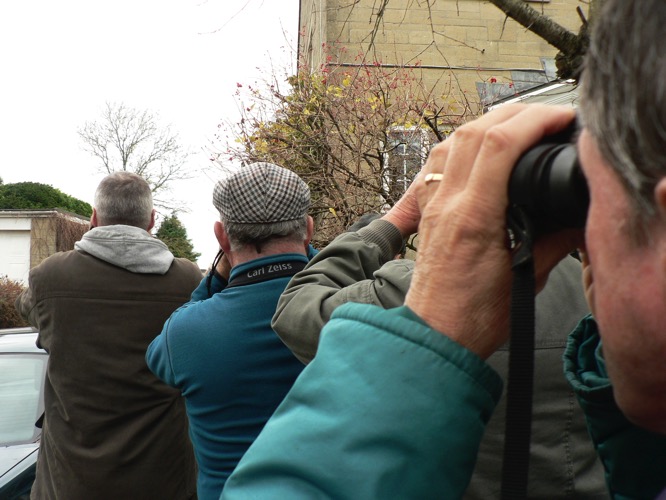Twitchers get their bird
12 03, 09 Filed in: Strange Days | Everything

I’ve not long arrived in East Coker, two miles south west of Yeovil in Somerset – and have only managed to raise my binoculars for the fourth time – when a man in his mid-thirties marches as briskly from his car as his arsenal of optical equipment allows and asks me, “Is it showing?”
“It’s showing well,” I offer, in the manner of a Cold War era exchange of code words in the vicinity of an East German dead letterbox, but he hardly needs to be told because all of us, to a man, are staring so hard at a shed roof I fear we may burn a hole in the felt.
The formalities over, I give him the benefit of my considerable insight into the matter, gleaned from four or five minutes of intensive experience as a twitcher.
“It's nipping in and out of that Leylandii”, I tell him and after an appreciative nod, I lose him to the lure of a small slate-grey bird hopping about a shed roof.
Twitchers – the paramilitary wing of the birdwatching community – seem to exchange all their information in these urgent, staccato bursts. Dedicated to ticking off as many species as their leisure hours permit, they have evolved an efficient shorthand that sums up the facts in short order and, in this case, the facts are that there are half dozen of us standing on a driveway in a leafy village close and we are all here staring at a Dark-Eyed Junco – a mega-rarity, in birding parlance – which has found its way from North America to the roof of a garden shed in Somerset.
The shed’s custodian for the day is Stephen Tervit, who is looking after his parents’ home while birders, who have come from as far afield as Leicester and Shropshire, come and go all day. It turns out that there are another half a dozen of them sitting in the Tervit conservatory watching the Leylandii like mildly peckish Sparrowhawks. A number of them troop out with impossibly large spotting scopes and telephoto lenses and exchange observations about the bird’s feeding behaviour as they sit on the front step putting on their boots. Everyone is animated and affable – pleased, as one of them remarks, with “an excellent garden twitch”. A little donations tin on the kitchen table proves they are obliging as the bird is, having collected over £200 for the RSPB.
Tervit appears briefly at the door to tell us the form for the day – it seems as though we’ll all get a chance to do some armchair birdwatching sooner or later. A life-long birder himself, he happened to notice the Dark-Eyed Junco after filling the bird feeders in his parents’ garden and recognised it instantly, having seen the species on a holiday in the States, where they are abundant. A neighbour, another birder, put out the news on the twitching grapevine – until the 1990s an informal collection of public telephones in pubs near twitching hotspots, but now a 21st century network of web sites, text messaging and pager services. By the end of the first day, Tervit says, around fifty people had come to have a look. At least as many arrived the next day and now, on the third, I’ve seen around twenty birders in the hour or so I’ve been here.
“There was one earlier this year in Dungeness, so a lot of the more serious twitchers who saw it might not make the journey for another”, says Tervit but notes with pride that, “this one’s showing better, according to some folk”.
The Junco itself is variously described as an American Sparrow or Bunting, but at first sight reminds me more of a kind of monochrome Robin. It appears to be in very good health and, despite being various shades of grey with a dull pink beak it’s undeniably stunning. It probably found its way to Somerset after being blown off course during its autumn migration and, according to Tervit, “may even have finished its journey on a ship”.
The flow of birders continues on into the second hour and I’m aware that many of the people I arrived with have long since left. Having watched and ticked, the twitcher’s dilemma is what to do with it. The answer is simple: apparently, there’s an even rarer bird about that needs attending to – a Steppe Grey Shrike has made it from Siberia to Lincolnshire.
After years of birding resisting the temptation to turn twitcher, I’m now hopelessly hooked. As I wait for a taxi to take me to my train, yet more birders turn up. One, a middle-aged man in a sports car, leans out of his window to ask where the Junco is. After some directions, he turns to the real matter in hand. “Is it showing?”
“It’s showing well”.
blog comments powered by Disqus
